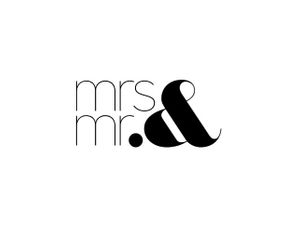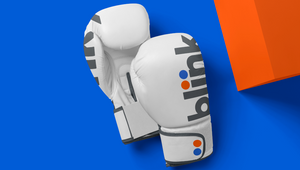
By Design: Creating a Visual Symphony with Kate Wadia

Kate has spent the better part of two decades creating and crafting design forward work for companies that believe in the transformative power of design & storytelling. Her work is informed by her belief in the alchemy of curiosity, creativity and close collaboration - yet it is multidisciplinary, covering the realms of design, advertising, physical experiences, product development, packaging and production.
Kate has worked both client and agency side across Melbourne, London and New York. In an industry where less than 3% of Creative Directors are women, Kate founded Mrs&Mr to right the ratio, and on the basis that good creative is most impactful when married - literally - to brilliant strategic thinking.
Kate hails from Melbourne, her unbridled optimism and sunny disposition a likely result of growing up down under.
LBB> Tell us about your current role and design specialism(s)?
Kate> I’m the founder and creative director of Mrs&Mr, a seven-year-old independent design agency.
During my training in Australia, we were taught to be generalist designers. When I came to America 20 years ago, people didn’t always know what to do with me because of my portfolio, which was very broad. It had packaging, advertising, experiential, fashion design and brand identity. They didn’t know where to put me because design back then was quite siloed. Packaging design stayed over here, brand identity stayed over here, advertising stayed over here.
Now, with media so fragmented, people experience brands across many channels and platforms. It’s like surround sound. Being a specialist can hurt you because you need to be able to look at a brand holistically, take that brand identity and visual world and give it meaning across consumer touchpoint.
LBB> What drew you to design in the first place and how has your design career evolved?
Kate> My mother was a milliner. I grew up in an environment that was really creative with an array of colours. There was a bright yellow laundry and a kelly-green hallway, a cobalt-blue kitchen, and my bedroom had red shag carpet in it. My mother was very crafty. We would tie-dye sheets and do macrame on the weekends.
I actually don’t know how I channelled that into design. I changed schools to be able to major in graphic design and graduated from the Royal Melbourne Institute of Technology for Design. I worked in Australia for a while, then spent two years traveling the world. I fell in love with New York and turned up there with no job, no visa, and tried my luck. Here I am, still.
LBB> What aspects of design do you get really nerdy about personally?
Kate> All of them. There is no logo, no typeface, nothing that cannot be noodled with. The devil is in the details with design. Spending the time crafting and pushing the details is so important. I sit in the New York subway and look at subway ads. I look for bad typography and fix it in my head. A good idea can die if it’s not executed and crafted well. It takes time. You have to take it off the computer. It can’t just be digital.
We always start with pen and paper to have a human aspect to our work. The crafting, the massaging, the nipping and tucking; every aspect of design is important, and that shows up in the end product.
LBB> There are so many new design tools out - what tools do you like to use and why? (whether digital platforms or old-fashioned pen and paper!)
Kate> I always start in analogue. Pen and paper.
People are so focused on new digital platforms and new design tools. From an efficiency standpoint, we work with Figma, with Nero. But why do we have all these new tools? What is lacking in a lot of branding out there is that people are not putting pen to paper. They’re not going back to the printing presses and old methods of design and colliding them with new tools and technologies to create outstanding work.
For us, it’s less about new tools. They are there for efficiency and amplification. They bring a lot of value to us, including AI. But the real magic comes when you collide new design tools with analog ways of working, which are timeless and bring a profound sense of humanity to the work.
People are attracted to work that has a human touch, that has a craft to it. As I said earlier, the devil is in the details. Those teeny-tiny details are what’s so important. You should never be okay with good. It needs to be great, and I don’t think AI is there yet. You still need that eye of a creative person and that sense of humanity in the work.
LBB> Design Thinking - thoughts?
Kate> It’s about using design to solve problems rather than using design to decorate. We are problem solvers. In the past, business or brand problems were often cracked through management consultants or brand consultants. These have value, but increasingly people and businesses see that design has a real, tangible role in solving a problem. Design thinking is really about solving thorny issues in a way that people will experience them. Not academic, not intellectual, but real, tangible, visceral.
LBB> What are the most persistent misconceptions about your particular design specialism that you see across the advertising and marketing landscape?
Kate> Some still think design or branding is just about a logo, or a colour palette. Design is there to create a visual symphony for how a brand shows up in the world in a way that is cohesive, and distinctive.. In advertising and marketing, design is still often seen as decoration.
The designers must make it look good as opposed to fundamentally understanding that advertising and marketing should be design led.
LBB> What design controversies or challenges do you find trickiest to navigate or do you find yourself thinking about most frequently?
Kate> I have huge respect for the design community at large. However I do find that some design agencies have not done the industry justice by engaging in “blanding,” which is when all brands just start to look the same, lack character, intrigue. The biggest challenge is in making sure that our clients understand that the role of great design is to create distinction. It’s not to blend in. It’s not to show up to the same Instagram party as everybody else, but to find your voice, to bring to life the DNA of the brand that makes it unique.
One of the biggest challenges is how do you evolve the branding for a legacy brand with deep heritage, without creating a backlash? You see what happened with Johnson and Johnson recently. We recently worked on the rebrands for Pepsi and Tabasco, and proud that we could retain what is special about their heritage, while injecting the brand with relevance for new generations of consumers.
LBB> What’s going on at the moment in design that’s getting you particularly excited?
Kate> It’s less about what’s going on in design, specifically, but what’s going on in culture with design. AdAge, a daily publication for decision makers and disruptors across the marketing and media landscape, has always awarded advertising, but 2023 was the first year they included design agencies as part of their awards. Their acknowledgement of it signals that design is no longer playing second fiddle to advertising.
I am also excited to see the extent to which our clients and businesses at large are investing in design within their own teams. Building out in-house design capabilities to partner with agencies like ours. That’s when the magic happens, and the best design work we created was born out of those partnerships where design has a seat at the table within our client’s organisation.
LBB> Thinking of people at the beginning of their career, what advice would you give them for navigating this constantly changing field?
Kate> Be more hungry, more passionate, more creative than the next person. Put your hand up. Ask for more, be resilient and willing to give anything a go. Don’t be precious about the work you take on. Just get in there, work harder, and prove yourself. Get messy because you don’t know where these opportunities might lead.
You really need to live and breathe design. It can’t just be a job. When I’m out in the streets, I’m looking at colours and typefaces. I’m looking at different combinations. I’m looking at nature for colours. Inspiration is everywhere. Never close your eyes. Always be curious. Suck it all in like a sponge, and then it somehow comes out in your work.
When we’re hiring people, we are looking for Swiss Army knives that don’t necessarily have design specialism, but they can think about design holistically. It’s part of the reason why our portfolio can include brands from Pepsi to Plenty of Fish, which is a pure dating app. It doesn’t get more digital and techie than a dating app. And we have SoulCycle, which is a physical space. Or the Google Hardware store, which is retail design.
The point is by having more of a Swiss Army knife approach to design, it means that you get to work and solve many more different types of design challenges than if you are a packaging designer or a website designer.
LBB> What are some of your favourite examples of creative design solutions that inspire you?
Kate> The ultimate experience is Disneyland. That is the ultimate experience to design. Disneyland was doing experience design before anyone else was in terms of the holistic approach. Everything is on point—the food, the trash cans, the characters, the wayfinding. Everything in that world is exactly of that world. I don't know if that feels irrelevant, but that’s actually the ultimate. That’s experience design.













